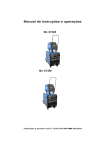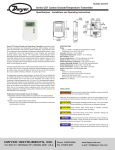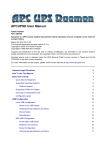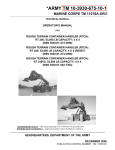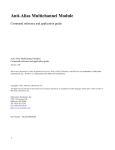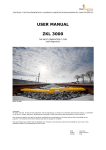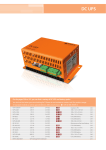Download AS 60-200KVA TECHNICAL DATA
Transcript
AS 60-200KVA TECHNICAL DATA Type AS UPS rated output kVA (cos ϕ = 0,8) Rectifier input data Rated current without battery charging A Rated output power without batt. charging kVA Max. current at highrate batt. charging A Max. output power kVA Power factor cos ϕ (typical) Rated voltage Rated frequency Required fuse protection Diazed/NH Type GL A Current harmonic distortion Starting time incl. precharge Link circuit - battery Recommended number of cells max. DC current A Rated batt. charging current of 10min-battery A max. battery charging current A Charging current pre-setting – normal A – high rate A Continuos charging voltage Equalising charging voltage Discharge voltage Voltage tolerance Residual ripple Charging characteristic Inverter output data Rated active power (cos ϕ = 1) Rated current (cos ϕ = 0.8) Rated current (cos ϕ = 1) Rated voltage Rated frequency Voltage tolerance – static – 50% unbalanced load – 100% unbalanced load – dynamic with 100% load change 60 60 80 80 84 58 96 67 109 75 127 88 125 162 4 26 192 215 6 34 318 10 52 160 160 200 200 207 143 246 170 255 177 306 212 250 315 2 x 198 2 x 203 2 x 253 2 x 12 2 x 14 2 x 33 2 x 42 I10 I5 2,23 – 2,3 2,4 1,65 ± 1% ≤ 1% DIN 41773 48 87 70 64 116 92 96 173 139 128 231 185 160 289 231 3/N 400 V ± 5% adjustable 50 Hz ± 1% ± 1% ± 3% < 5% < 10 ms Settling time Angular deviation – symmetrical load – 50% unbalanced load – 100% unbalanced load Frequency tolerance – line commutation – self commutation AS IV_Tech_Data.doc 09.04.02 156 108 186 129 ≥ 0,97 3/N 400 V ± 15% 50 Hz ± 5% 160 200 ≤ 5% 30 s V/Cell V/Cell V/Cell kW A A 120 120 < 1° < 2° < 3° ± 1% ± 0,1 % We reserve the right to change without notice! 1 AS 60-200KVA Type AS UPS rated output kVA (cos ϕ = 0,8) Distortion factor (EN 50091-1) – linear load – non linear load Crestfactor Overload – 3ph – 1ph Short-circuit characteristics – 3ph – 1ph Inverter efficiency with rated load Automatic Bypass Rated voltage Rated frequency Overload capacity – 10 min – 100 ms Inverter/Bypass changeover time – inverter fault – overload or man. operation Bypass/Inverter changeover time Required fuse protection Diazed/NH Type GL A General Data Overall efficiency – 100% load % – 75% load % – 50% load % – 25% load % Power dissipation – 100% load kW – 75% load kW – 50% load kW – 25% load kW 3 Air rate required m /h Noise level at a distance of 1m Permiss. ambient temperature Relative humidity Installation altitude Humidity class Protection type Insulation group Radio interference level Dimensions – width – depth – height Weight Floor loading AS IV_Tech_Data.doc 09.04.02 kg 2 kg/m 60 60 80 80 120 120 160 160 200 200 < 1% < 5% ≥3 150 % 30 s, 125 % 10 min 220 % 30 s, 180 % 10 min 200 % 20 ms, 150 % 3 s 350 % 20 ms, 260 % 3 s 98 % 400 V 50 Hz 150 % 1000 % 100 125 2 ms 0 ms 0 ms 200 91 92 92 92 92 4,75 5,6 8,5 10,3 13 2000 2000 ca. 900 804 895 1400 ca. 900 250 315 2500 2500 2500 67 dB(A) 0 – 40°C daily average ≤ 35°C 5 % - 95 % without condensation <1000 m above mean sea level without power reduction DIN/IEC 721 2-1-09/86 IP 21 (DIN/VDE 0470 part 11/92 IEC 529) DIN/VDE 0110, Overvoltage category 2, Fouling factor 2 EN 50091-2 Standard class A We reserve the right to change without notice! ca. 1100 see section 0 993 815 1802 ca. 850 ca. 850 2 AS 60-200KVA Type UPS rated output (cos ϕ = 0,8) Paint finish Cable connection AS kVA 60 60 80 80 120 120 160 160 200 200 RAL 7035 textured from bottom Specifications complied with: DIN/VDE 0100 DIN/VDE 0103 DIN/VDE 106 part 1 IEC 536 DIN/VDE 0110 01/89 DIN/VDE 0160 DIN/VDE 470 part 1 11/92 IEC 529 DIN/VDE 0510 part 2 10/97 DIN/VDE 0558 part 5 09/88 IEC 146-4 DIN/VDE 0558 part 6 04/92 IEC 146-5 DIN EN 50091-1, VDE 0558 part 510 DIN EN 50091-1-1, VDE 0558 part 511 DIN EN 50091-2, VDE 0558 part 520 DIN/IEC 721-2-1-09/86 Protection against electric shock after VBG 4 DIN 41772 DIN 45635 part 1 04/84 IEC 801 Battery: DIN/VDE 0510 part 2 07/86 AS IV_Tech_Data.doc 09.04.02 We reserve the right to change without notice! 3 AS 60-200KVA Dimensions Air outlet (1396) Air inlet A A (804) 793 Air inlet 880 15 895 Sectional A - A ( also shown space requirement ) ca. 861 793 34 150 34 Cable entry (input or output) bottom 510 148 87 81,5 Fluchtweg n. VDE 100 Teil 729 Escape acc. to VDE 100 Piece 729 (525) 294 Open door angle 180° Fig. 1 APOSTAR 60 – 120 kVA Dimensions and space requirements AS IV_Tech_Data.doc 09.04.02 We reserve the right to change without notice! 4 AS 60-200KVA Air outlet A A 1802 Air inlet Air inlet 778 993 800 15 Air outlet A-A (also showing the space requirement) 570 100 800 650 92 16 60 Ø 790 Fluchtweg n. VDE 100 Teil 729 100 294 100 Escape acc. to VDE 100 piece 729 (575) 140 87 Cable entry/ Cable output bottom 100 25 60 940 200 25 Aperture angle of the doors 180° Doors can be unhinged with an aperture angle of more then 90° Fig. 2 APOSTAR 160 – 200 kVA Dimensions and space requirements AS IV_Tech_Data.doc 09.04.02 We reserve the right to change without notice! 5 AS 60-200KVA Baseframe 850 790 690 Door Fig. 3 APOSTAR 60 – 120 kVA baseframe 570 100 60 650 60 25 100 100 Door Ø 790 100 25 940 16 Fig. 4 APOSTAR 160 – 200 kVA baseframe AS IV_Tech_Data.doc 09.04.02 We reserve the right to change without notice! 6 AS 60-200KVA INSTALLATION AND CONNECTIONS Installation notes Goods inwards inspection Final inspection ensures satisfactory mechanical and electrical condition before that APOSTAR leaves the factory. Immediately after the equipment arrives, please check whether any freight damage has occurred and if necessary, bring this to the attention of the freight operator. In no circumstances put a damaged APOSTAR into service before your have consulted us! Transportation If required, the APOSTAR and the battery cubicles can be moved by means of a fork-lift or lift truck. Moving by crane should only be used in exceptional circumstances and only after consulting us. Ensure that the equipment is only transported upright and not tilted or turned over. Always avoid sharp impacts. Where possible leave the equipment in its original packing when moving it. This provides the best possible protection against damage. Storage The equipment should be stored in a dry, well-ventilated room that is free of aggressive materials. Where possible, the original packing should not be removed during storage. In no circumstances must the APOSTAR be left stacked or stored outside! Choice of installation site The APOSTAR is not designed for mounting against a wall, i.e. a clearance of at least 150 mm should be left to the wall. The following criteria should be observed when selecting the installation site: a. Floor loading capacity The weight of the equipment is distributed over a relatively small area; care must therefore be taken to en-sure that the floor loading capacity is adequate. The exact value can be obtained from the table below. If necessary, the support area can be increased by interposing a suitable load distribution rack. Please consult your architect, the clerk of works or us if you require assistance. Type AS IV_Tech_Data.doc 09.04.02 Floor loading capacity Compressive loads per unit area per feet 2 1,26 kg/cm 2 1,26 kg/cm 2 1,55 kg/cm AS 60 kVA 0,128 kg/cm AS 80 kVA 0,128 kg/cm AS 120 kVA 0,157 kg/cm AS 160 kVA 0,11 kg/cm AS 200 kVA 0,11 kg/cm 2 2 2 2 front: 3,5 kg/cm / back: 7 kg/cm 2 front: 3,5 kg/cm / back: 7 kg/cm We reserve the right to change without notice! 2 2 2 2 7 AS 60-200KVA b. Baseframe The necessary dimensions for constructing a base-frame, if required, can be found in Fig. 3 - Fig. 4. c. Space requirements As already stated, the APOSTAR cannot be installed with the rear side against a wall. A clearance of at least 150 mm should be left. About a metre clearance should be left in front of the unit to provide unimpeded access to the cubicle. Local or general safety regulations, e.g. escape routes as per VDE 0100, part 729, should also be observed. A clearance of at least 40 cm should be left above the APOSTAR to allow the warm air to be freely exhausted. In no circumstances must the air inlet and air outlet be covered or blocked. d. Installation altitude, temperature and humidity The APOSTAR is designed for an installation altitude of up to 1000 metres above mean sea level, an ambient temperature of 0 to 40°C (daily average ≤ 35°C) and a relative humidity of up to 90 %. The optimum temperature is around 20°C. Please consult us if planning an installation above 1000 metres. Please ensure that any existing airconditioning plant meets these conditions and is also able to remove the unit's dissipated heat. Details are shown in the technical data. The cooling air must always be free of aggressive agents. Battery – general notes As special equipment for the APOSTAR UPS, PILLER supplies battery sets for bridging mains failure periods. If the system power and required back-up time allow, the sealed lead-acid batteries are built into a cubicle that is matched to the UPS cubicle and can be in-stalled immediately next to it. But a more remote installation is also possible. Please discuss your special requirements with us. The optimum ambient temperature for the batteries is 20 °C. Temperatures considerably higher than this shorten the service life of the batteries. If open batteries are used, a specially-equipped battery room must be provided. This must meet the various safety requirements. Contact your appropriate local authority for further details. A battery installation should also meet DIN VDE 0510 procedures. Please note that batteries have only a limited storage life. Please contact us or the battery manufacturer if you intend storing the battery sets for more than a few days. WARNING The battery sets for the APOSTAR system are charged up when delivered. Improper handling can cause injuries or damage. When connecting the battery sets ensure that the connecting terminals are "dead”, e.g. by opening the fuse-disconnector. Check that the circuit is dead before making connections. AS IV_Tech_Data.doc 09.04.02 We reserve the right to change without notice! 8 AS 60-200KVA Electrical connections General Connections for the APOSTAR are provided by terminal strips located in the lower third of the cubicle. The cables can be brought up to the cubicle from all four sides and led in through the bottom of the cubicle. A false floor in the installation room is not necessary. The tables and drawings hereafter indicate the cable connection points and the cable dimensions according to DIN VDE 0298. IMPORTANT You must ensure that the phases of the a.c. connections (clockwise rotating field) and the polarity of the battery connections are correct, as incorrect connections can cause damage to the equipment. Terminal assignment and cable sizes NOTE 1. The battery cables should not be longer than 15 m; the voltage drop not more than 1.5 %. Please consult us if you are unable to meet these requirements. Page 20 shows the recommended cable types. When determining the cable lengths bear in mind that about 0.50 m of cable is required inside the cubicle. 2. In the event of a fault in the UPS set, e.g. short-circuit, the input fuse of the unit must trip before the mains fuse since only then is transfer to the bypass mode possible without a break. Diazed/l.v.h.r.c. type GL fuses should therefore be used as mains fuses. The minimum fuse rating can be obtained from the table hereafter. UPS-power (kVA) AS IV_Tech_Data.doc 09.04.02 Fuse (A) Mains 1 Mains 2 60 125 100 80 160 125 120 200 200 160 250 250 200 315 315 We reserve the right to change without notice! 9 AS 60-200KVA The table hereafter shows the power cables required for the APOSTAR UPS according to DIN VDE 298. Maximum currents and power cables Temperature factor: 35 °C = 0,94 Cable tray with free air circulation, spacing = cable diameter d UPSType Mains 1 1 L1-L3, N, PE 60 96 A 1 x NYCWY 4 x 35RM/16 87 A each 1 x NYCWY 4 x 35RM/16 162 A 1 x NYY-0 4 x 16RE 80 127 A 1 x NYCWY 4 x 50SM/25 115 A each 1 x NYCWY 4 x 50SM/16 215 A 1 x NYY-0 4 x 25RE 120 186 A 1 x NYCWY 4 x 95SM/50 173 A each 1 x NYCWY 4 x 95SM/50 318 A 1 x NYY-0 4 x 50SM 160 246 A 1 x NYCWY 4 x 120 231 A each 1 x NYCWY 4 x 120 2 x 203 A 2 x NYY-0 4 x 50SM 200 306 A 2 x NYCWY 4 x 70 289 A each 2 x NYCWY 4 x 50 2 x 253 A 2 x NYY-0 4 x 50SM Mains 2 L1-L3, N, PE Output 2 L1-L3, N, PE Battery 3 +/- The following table should be noted when laying parallel cables: Temperature factor: 35 °C = 0,94; Cable installation factor: 3 cables in parallel = 0,8; total = 0,752 2 Cross-section (mm ) 10 16 25 35 50 70 95 120 150 Loadability incl. factor 0,752 in A Multi-conductor cable Single-conductor cable DC AC DC AC 49 45 59 49 67 60 79 67 89 78 105 89 109 98 131 109 132 119 159 132 168 152 202 168 204 183 249 204 236 212 290 236 271 243 332 271 The protective earth and N connection of the UPS should be provided by both infeeds so that the cables have full redundancy. For symmetry, when possible and if permitted, 3-core cable type NYCWY (full crosssectional sheath) and a separate protective conductor should be used. 1 2 3 In case of large capacity batteries and/or high-rate charging option, please consult us about the cable layout. With only one network input, the same cable cross-section as used for Mains 1 should be selected for the output. In any case all battery cubicles or racks must be grounded. AS IV_Tech_Data.doc 09.04.02 We reserve the right to change without notice! 10 958 AS 60-200KVA Batt. 24 6 78 9 N3 1 3 5 N2 X1 N1 Mains 2 Mains 1 Output +- 1 2 X4 350 PE 127 250 25 78 41 254 18 Fig. 5 Cabinet terminal arrangement APOSTAR 60 - 80kVA Terminal X1 2 4 6 N UPS-Input (Mains 1) UPS-Input (Mains 1) UPS-Input (Mains 1) UPS-Input (Mains 1) L1 L2 L3 N2 Terminal X1 1 3 5 N Bypass-Input (Mains 2) Bypass-Input (Mains 2) Bypass-Input (Mains 2) Bypass-Input (Mains 2) L1 L2 L3 N1 Terminal X1 7 8 9 N UPS-Output UPS-Output UPS-Output UPS-Output L1 L2 L3 N3 Terminal X4 1 2 Battery-Input Battery-Input + – AS IV_Tech_Data.doc 09.04.02 We reserve the right to change without notice! 11 954 AS 60-200KVA Batt. 2 4 6 78 9 N3 1 3 5 N2 X1 N1 Mains 2 Mains 1 Output +- 1 2 X4 350 PE 90 310 55 243 47 18 31 Fig. 6 Cabinet terminal arrangement APOSTAR 120kVA Terminal X1 2 4 6 N UPS-Input (Mains 1) UPS-Input (Mains 1) UPS-Input (Mains 1) UPS-Input (Mains 1) L1 L2 L3 N2 Terminal X1 1 3 5 N Bypass-Input (Mains 2) Bypass-Input (Mains 2) Bypass-Input (Mains 2) Bypass-Input (Mains 2) L1 L2 L3 N1 Terminal X1 7 8 9 N UPS-Output UPS-Output UPS-Output UPS-Output L1 L2 L3 N3 Terminal X4 1 2 Battery-Input Battery-Input + – AS IV_Tech_Data.doc 09.04.02 We reserve the right to change without notice! 12 78 9 N3 Mains 3 X1 PE PE 207 333,5 24 6 N2 X1 1 3 5 N1 Mains 1 Mains 2 Batt1. + Batt1. Batt2. + Batt2. - 1375 AS 60-200KVA 100 216 274 108 52 108 100 36 Fig. 7 Cabinet terminal arrangement APOSTAR 160 – 200 kVA Terminal X1 2 4 6 N UPS-Input (Mains 1) UPS-Input (Mains 1) UPS-Input (Mains 1) UPS-Input (Mains 1) L1 L2 L3 N2 Terminal X1 1 3 5 N Bypass-Input (Mains 2) Bypass-Input (Mains 2) Bypass-Input (Mains 2) Bypass-Input (Mains 2) L1 L2 L3 N1 Terminal X1 7 8 9 N UPS-Output UPS-Output UPS-Output UPS-Output L1 L2 L3 N3 Terminal X4 1 2 Battery-Input Battery-Input + – AS IV_Tech_Data.doc 09.04.02 We reserve the right to change without notice! 13 AS 60-200KVA Terminal types and dimensions The conductor cross-sections of the UPS terminals (box terminals or cable lugs) are shown in the following table. UPS-Type Cable type 60 kVA 80 kVA 120 - 200 kVA rigid flexible rigid flexible rigid flexible 2 25 35 35 50 70 70 2 95 95 150 150 240 240 min. mm max. mm stripping the cables mm 30 38 38 Neutral conductor and PE conductor connections The PE connections and the N-connections of the external manual bypass are attached to the corresponding copper bars by means of M8 screws. AS IV_Tech_Data.doc 09.04.02 We reserve the right to change without notice! 14 AS 60-200KVA Connection for external operation and monitoring Customer interface card, terminal strip X1 Terminal strip X1 is used by the customer to match the UPS to his own electronic installation, such as UPS-blocked circuit, remote control signals and Diesel stand-by generating set. UPS blocked/Off If an external contact is to be added, then the links between EPOint X1.1 and EPOext X1.2 should be removed and replaced by an N/C contact of the external UPS-blocked button. Remove link for external “UPS blocked”! Ext. APOSTAR off 1 X1 2 3 4 Remote on 5 GND 6 7 8 Remote Bypass on 9 10 11 12 UPS Diesel mode 13 14 15 16 Battery charging off 17 18 19 Remote off 20 21 Ext. Output breaker is open Fig. 8 Terminal strip A230 X1 External manual bypass General Two variants are available for the UPS installation. The standard version, in which the manual bypass (bypass contactor) is built into the set, and an extended version in which an additional, external manual bypass can be supplied. This is located, along with additional necessary isolators, in a separate adjacent cubicle. The decisive advantage of this extended version is that the UPS cubicle can be completely isolated, thus allowing the necessary maintenance and repair operations to be carried out safely in the UPS cubicle, without having to interrupt the supply to the load. AS IV_Tech_Data.doc 09.04.02 We reserve the right to change without notice! 15 AS 60-200KVA Installation and connections The auxiliary cabinet for the external manual bypass is placed immediately to the right or the left of the UPS cabinet. To do this, remove the right-manual side panel of the UPS cabinet. This is used as the side panel of the auxiliary cabinet. Lead the cables through the openings in the bottom of both cabinets and attach them to the corresponding terminals in the UPS cabinet. Q500 Q50 Bypass input (Mains 2) X50 Q60 UPS Mains supply (Mains 1) X60 Load X10 Fig. 9 External manual bypass AS IV_Tech_Data.doc 09.04.02 We reserve the right to change without notice! 16 AS 60-200KVA Battery cabinet connections When several battery cabinets are interconnected, one battery set can be housed in several cabinets (series connection) or several sets can be connected in parallel to increase the capacity. Battery cabinet + Battery cabinet + 4 - 2 1 + + - 1 - + + - - - - 2 - =1 + X4 UPS Fig. 10 Battery cabinets connected in series Battery cabinet + Battery cabinet + 4 - 2 1 + + - 1 2 =1 + X4 - - + + UPS Fig. 11 Battery cabinets connected in parallel AS IV_Tech_Data.doc 09.04.02 We reserve the right to change without notice! 17

















